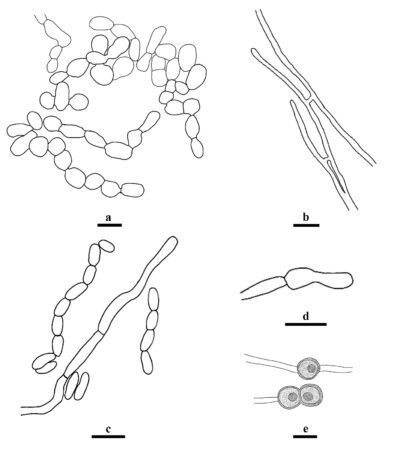Fungalpedia – Note 412, Fodinomyces
Fodinomyces Vázq.-Camp.
Citation when using this data: Tibpromma et al. (in prep.) – Fungalpedia, Ascomycota.
Index Fungorum, Facesoffungi, MycoBank, GenBank, Fig. 1
Classification: Teratosphaeriaceae, Mycosphaerellales, Dothideomycetidae, Dothideomycetes, Pezizomycotina, Ascomycota, Fungi
Fodinomyces was introduced by Vázquez-Campos et al. (2014) and typified with Fodinomyces uranophilus based on morphology and phylogeny analysis of ITS and LSU. Only F. uranophilus is accepted in this genus, with only the asexual morph known, isolated from a uranium mine in northern Australia (Vázquez-Campos et al. 2014). Fodinomyces is characterized by greenish glaucous to black, surface flat or with a raised center, either cracked, cerebriform or papillate colonies, septate, branched, colorless to slightly brownish or greenish hyphae, and polymorphic conidiophores and conidia (Vázquez-Campos et al. 2014). Based on the phylogenetic analysis of ITS, F. uranophilus is a sister to Penidiella aggregata and forms a clade with Catenulostroma protearum and Recurvomyces mirabilis (Vázquez-Campos et al. 2014). However, phylogenetic analyses based on LSU demonstrated different results, with F. uranophilus always proving to be phylogenetically close to Penidiella rigidophora, P. aggregata, P. drakensbergensis, Catenulostroma chromoblastomycosum, C. corymbiae, Friedmanniomyces spp., Elasticomyces elasticus and Teratosphaeria encephalarti (Vázquez-Campos et al. 2014). According to the phylogenetic analysis of ITS or LSU, F. uranophilus did not cluster with the type species of Penidiella or Teratosphaeria. Fodinomyces uranophilus clustered with the type species of Catenulostroma (Catenulostroma protearum) in the ITS analysis, and there was little sequence similarity to either ITS (88%) or LSU (87%) sequences, justifying the classification of Fodinomyces (Vázquez-Campos et al. 2014).
Type species: Fodinomyces uranophilus X. Vázquez-Campos
Other accepted species: Species Fungorum – search Fodinomyces
Figure 1 – Morphological features of Fodinomyces uranophilus. a Late-stage conidia and conidiophores. b Anastomoses. c Tallic-arthric conidia. d Early-stage peanut-shaped conidia. e Chlamydospore-like structures. Scale bars: a–e = 10 μm. Redrawn from Vázquez-Campos et al. (2014).
References
Entry by
Liu XF, Center for Yunnan Plateau Biological Resources Protection and Utilization, College of Biological Resource and Food Engineering, Qujing Normal University, Qujing, Yunnan 655011, China; Center of Excellence in Fungal Research, Mae Fah Luang University, Chiang Rai 57100, Thailand; School of Science, Mae Fah Luang University, Chiang Rai 57100, Thailand.
(Edited by Saowaluck Tibpromma, Samaneh Chaharmiri-Dokhaharani, & Achala R. Rathnayaka)
Published online 26 November 2024
